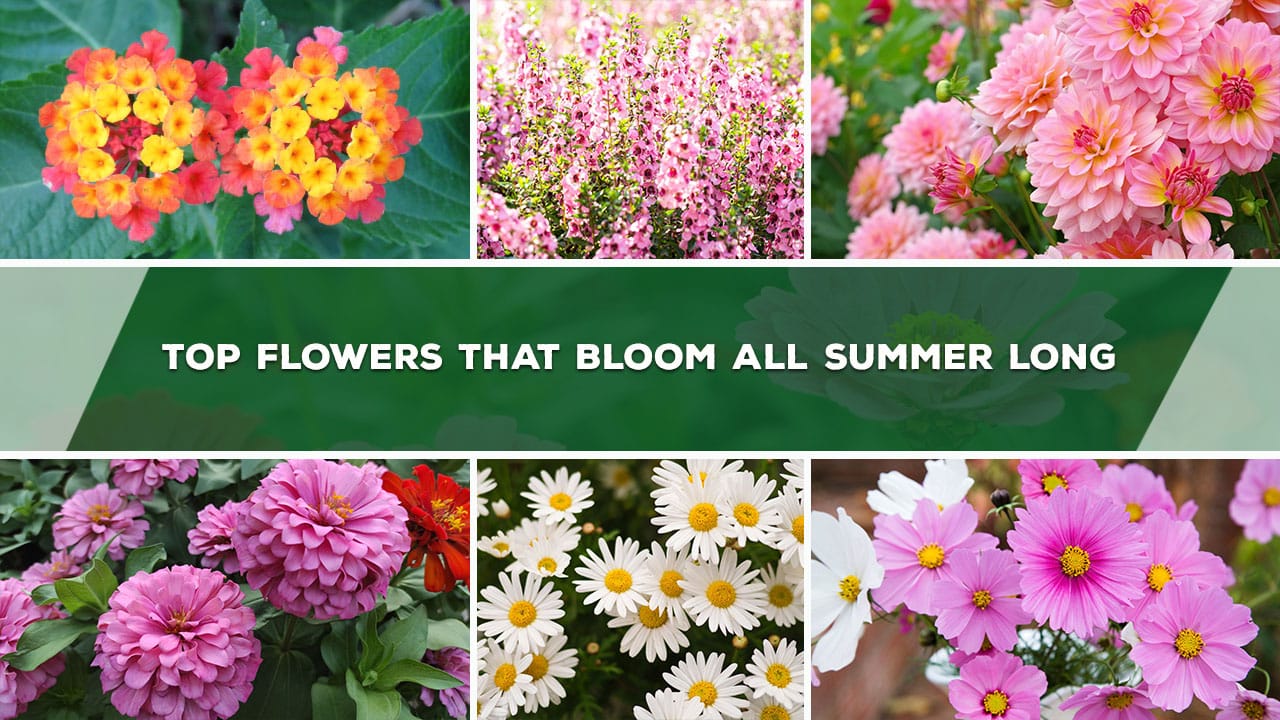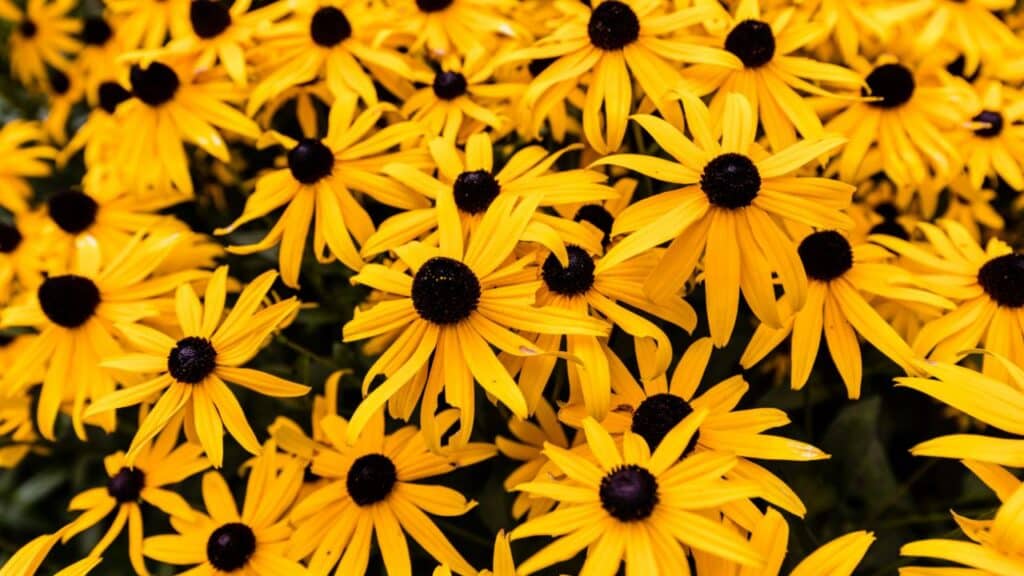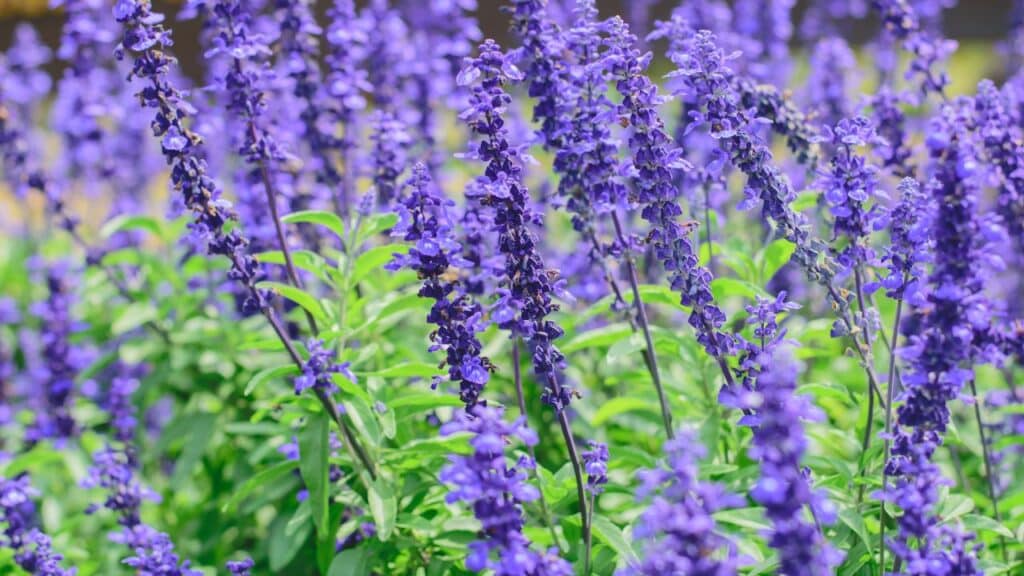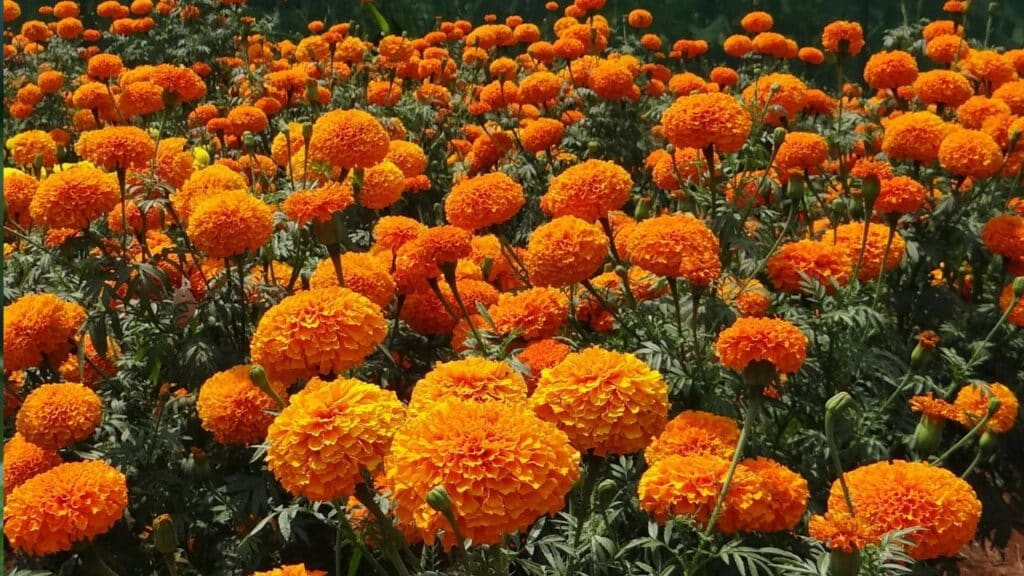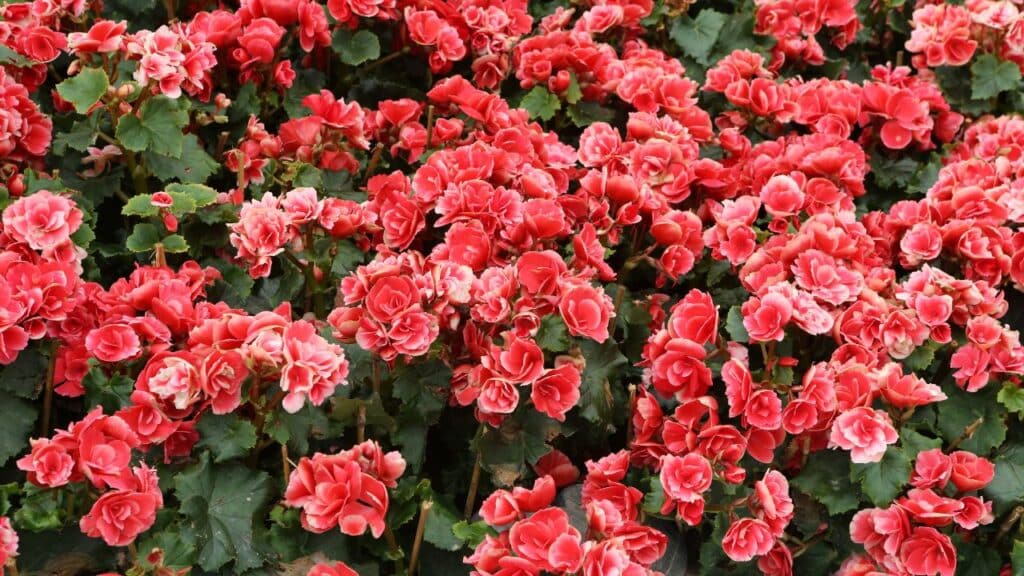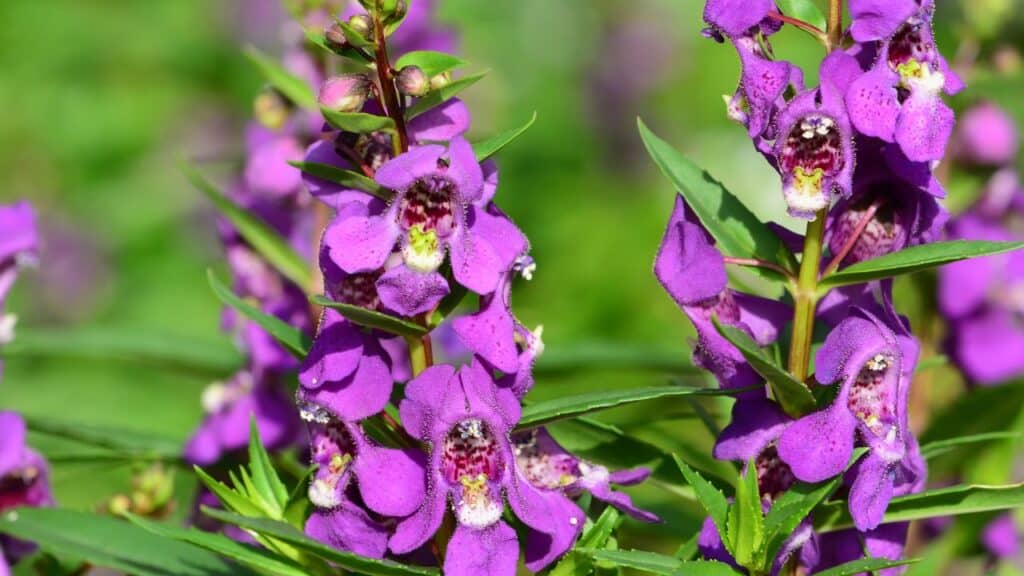Summer gardens burst with color and life. Many flowers bloom for a few weeks, but some keep going strong all season. These long-blooming plants are perfect for adding constant beauty to your yard. You can enjoy vibrant flowers from spring through fall by choosing the right mix of plants that bloom all summer.
With so many options available, you can easily create a garden full of non-stop color. Both annuals and perennials can provide months of blooms. Some popular choices include verbena, coneflowers, and lavender.
By selecting a variety of summer-long bloomers, you’ll have a stunning display that lasts until the first frost.
1. Black-Eyed Susan
Black-Eyed Susans bring cheerful golden blooms to your garden all summer long. These hardy flowers are easy to grow and care for, making them perfect for beginners and experts.
You’ll love the bright yellow petals surrounding a dark brown center. Black-Eyed Susans grow about 2-3 feet tall and spread quickly, filling empty spaces in your garden with vibrant color.
Plant these sun-loving flowers in spring after the last frost. They thrive in full sun and well-drained soil. Water them regularly when young, but they’re pretty drought-tolerant once established.
Black-Eyed Susans attract butterflies and bees to your garden. They’re great for cut flowers, too, lasting up to a week in vases. Deadhead spent blooms to encourage more flowers throughout the season.
These versatile plants work well in many garden styles. Use them in wildflower meadows, cottage gardens, or mixed borders. They also make excellent container plants for patios and balconies.
Some varieties, like ‘Green Eyes,’ offer unique twists on the classic look. This cultivar features bright green centers instead of the typical dark brown, adding interest to your garden palette.
2. Coneflower
Coneflowers are stunning perennials that will brighten your garden all summer long. These hardy plants bloom from early summer until the first frost, giving you months of colorful flowers.
Native to North America, coneflowers are easy to grow and maintain. They come in various colors, but purple is the most common. The flowers have drooping petals surrounding a distinctive cone-shaped center.
You’ll love how coneflowers attract butterflies and bees to your garden. These pollinators are drawn to the nectar-rich blooms, making your outdoor space buzz with life.
Coneflowers are drought-tolerant once established, making them perfect for low-water gardens. They thrive in full sun and well-drained soil. Plant them 1 to 3 feet apart to give them room to grow.
These flowers can reach heights of 1 to 4 feet, depending on the variety. Some popular types include ‘Primadonna Deep Rose’ and ‘Eye Catcher Canary Feathers.’ The latter boasts bright yellow petals with a golden cone.
Coneflowers make excellent cut flowers that last long in bouquets. Their large blooms, up to 4-6 inches wide, create stunning floral arrangements. You can also leave the seedheads on the plants to feed birds in winter.
3. Geranium
Geraniums are a garden favorite that can bloom all summer long. These cheerful flowers come in many colors, from pink and red to white and purple.
You can find both annual and perennial types of geraniums. Yearly varieties are often called “garden geraniums” or “zonal geraniums.” Perennial types are “hardy geraniums” or “cranesbill geraniums.”
To keep geraniums flowering, give them plenty of sunlight. They need at least 4-6 hours of direct sun each day. Water them regularly, but don’t let the soil get soggy.
Deadheading is critical for continuous blooms. Remove spent flowers by pinching them off at the base of the stem. This encourages the plant to produce more flowers.
Fertilize your geraniums every 4-6 weeks during the growing season. Use a balanced, water-soluble fertilizer to promote healthy growth and abundant blooms.
Some geranium varieties are especially good at blooming all summer. Look for ‘Rozanne,’ which produces violet-blue flowers, or ‘Ann Folkard,’ with its magenta blooms.
Geraniums attract butterflies and hummingbirds to your garden. They also work well in containers, hanging baskets, or as ground cover.
4. Shasta Daisy
Shasta daisies are summer favorites that can brighten your garden for months. These cheerful white flowers with yellow centers add a classic touch to any landscape.
You’ll love how easy Shasta daisies are to grow. They thrive in full sun and well-drained soil. Plant them in spring or fall for best results.
Shasta daisies start blooming in early summer and keep going strong until fall. With regular deadheading, you can enjoy their blooms even longer.
Popular varieties like ‘Snowcap’ and ‘Becky’ offer extended flowering periods. These tough plants are winter hardy in zones 5 to 9, making them versatile for many gardens.
The ‘Banana Cream’ variety offers a unique color show. Its flowers open lemon yellow, fade to butter yellow, then turn creamy white as they mature.
Shasta daisies attract butterflies, adding life to your garden. They also make excellent cut flowers that last long in bouquets.
Try compact varieties like ‘Daisy May for small spaces or containers.’ These smaller plants still pack a big punch with their showy blooms.
With proper care, your Shasta daisies will return year after year. Divide them every few years to keep them healthy and vigorous.
5. Coreopsis
Coreopsis, or tickseed, is a perfect choice for your summer garden. These cheerful flowers bloom all season long, bringing bright colors to your outdoor space.
Coreopsis plants love full sun and can handle dry, hot conditions. They’re easy to grow and don’t need much care. You’ll find many types of coreopsis, with yellow, orange, red, and pink flowers.
These plants attract birds, bees, and butterflies to your garden. They’re great for borders or filling empty spots in flower beds. Coreopsis flowers look like daisies and come in different sizes.
To keep your coreopsis blooming, remove dead flowers often. This helps the plant make new blooms. Water them during dry spells, but don’t overdo it. They don’t like too much water.
You can plant coreopsis in spring or fall. They grow well in most soil types as long as it drains well. Once they’re settled, these plants are tough and can handle drought.
Some popular coreopsis types include ‘Sterntaler’ with golden flowers and ‘Flying Saucers,’ which doesn’t spread independently. ‘American Dream’ is another excellent choice with pretty pink blooms.
With the proper care, your coreopsis will fill your garden with color all summer. They’re an excellent pick for both new and experienced gardeners.
6. Salvia
Salvia is a long-blooming flower that brings vibrant color to your garden all summer. You’ll love its eye-catching spikes of tubular flowers in shades of purple, blue, red, pink, and white.
These plants are easy to grow and require little care. Salvia thrives in full sun and well-drained soil. You can plant it in flower beds, borders, or containers.
Salvia attracts butterflies and hummingbirds to your garden. Its fragrant foliage adds another layer of enjoyment. Some varieties reach 2 to 5 feet, while others stay compact at 14 to 28 inches tall.
You’ll find salvia to be drought-tolerant once established. This makes it perfect for low-maintenance gardens. Many types are also resistant to deer and rabbits.
For unique colors, try the Skyscraper Orange variety. It offers stunning orange blooms that stand out in any garden or container. Other uncommon colors include light pink and dark purple.
Salvia keeps blooming from summer into fall, giving you months of colorful flowers. It’s an excellent choice for adding long-lasting beauty to your outdoor space.
7. Gaillardia
Gaillardia, the blanket flower, is a cheerful addition to any garden. These bright blooms will keep your outdoor space colorful all summer long.
You’ll love how easy gaillardia is to grow. It thrives in full sun and doesn’t need much water. This makes it perfect for dry or hot climates.
Gaillardia comes in many colors. You can find flowers in shades of red, yellow, orange, and burgundy. Some have two-toned petals that look like little suns.
These flowers attract butterflies and bees to your garden. They’re great for pollinators and will help keep your whole yard buzzing with life.
You can plant gaillardia in borders, containers, or rock gardens. They grow well in most soil types and don’t need much care.
Deadheading spent blooms will keep your gaillardia flowering longer. But even without this extra step, they’ll bloom for months.
Some popular types are ‘Arizona Sun’ and ‘Burgundy.’ These varieties are compact and produce lots of flowers throughout the season.
8. Daylily
Daylilies are a summer garden superstar. These tough perennials offer a burst of color that can last all season long.
You’ll love how easy daylilies are to grow. They adapt to many soil types and need little care once established.
Daylilies come in a rainbow of colors. You can find them in shades of yellow, orange, pink, purple, and even near-white.
Each daylily flower blooms for just one day. But don’t worry – a single plant produces many flowers over time.
Some daylily varieties are called “rebloomers.” These unique plants flower multiple times throughout the summer.
“Stella de Oro” is a popular reblooming daylily. It shows off golden-yellow flowers from late spring to fall.
Another great choice is “Happy Returns.” This variety produces lemon-yellow blooms all summer long.
For a different look, try “Purple d’Oro.” It offers lavender-purple flowers that keep coming back.
Daylilies grow well in full sun to partial shade. They can reach heights of 1 to 4 feet, depending on the variety.
You can plant daylilies in groups for a bold effect. Or mix them with other summer bloomers for a varied garden display.
9. Lantana
Lantana is a thorny, colorful flower that blooms all summer long. You’ll love how easy it is to grow and care for this heat-loving plant.
Lantana comes in many bright colors, like yellow, orange, pink, and red. The flowers grow in small clusters that look like tiny bouquets. Butterflies and hummingbirds love to visit lantana plants.
You can plant lantana in the ground or pots. It likes full sun and well-draining soil. Don’t worry if your soil isn’t perfect – lantana isn’t picky.
Water your lantana once a week during summer. Let the soil dry out between waterings. Too much water can stop it from blooming.
You don’t need to fertilize lantana much. A light dose of all-purpose fertilizer in spring
10. Zinnia
Zinnias are vibrant summer flowers that bloom from early summer until frost. You can find them in a rainbow of colors, including red, orange, yellow, pink, and purple.
These cheerful annuals are easy to grow from seed. Plant them after the last frost date in your area. Zinnias thrive in full sun and well-drained soil.
To keep zinnias blooming all summer, cut the flowers regularly. This practice, called deadheading, encourages more blooms. You can also pinch young plants to promote bushier growth.
Zinnias don’t need much fertilizer. A light application of balanced fertilizer at planting time is usually enough. Water them deeply but infrequently to encourage strong roots.
These flowers attract butterflies and bees to your garden. They make excellent cut flowers, too. Try planting different zinnia varieties for a mix of heights and flower shapes.
Zinnias are heat-tolerant and drought-resistant once established. They’re perfect for adding bold color to borders, containers, and cutting gardens. You’ll enjoy zinnia blooms from summer until the first frost with proper care.
11. Petunia
Petunias are a favorite for summer-long blooms. These colorful flowers come in many shades and patterns. They are in pink, purple, red, white, and even striped varieties.
To keep petunias blooming all summer, give them plenty of sun. They need at least 6 hours of direct sunlight each day. More sun means more flowers.
Water your petunias profoundly, but not too often. This helps their roots grow deep and strong. Deep roots make petunias more resistant to dry spells.
Fertilize your petunias every 10 to 14 days. Use a fertilizer with more phosphorus and potassium than nitrogen. This mix helps petunias produce more flowers.
Deadhead your petunias regularly. Remove old blooms to encourage new ones. This simple task keeps your plants looking fresh and full of flowers.
In hot climates, petunias may slow down in midsummer. Give them shade during the hottest part of the day to help them bounce back.
With the proper care, your petunias can bloom from spring until fall. They’re perfect for hanging baskets, window boxes, or garden beds. Their long-lasting flowers will bring color to your outdoor spaces all summer long.
12. Marigold
Marigolds are a summer garden favorite. These bright, cheerful flowers bloom all season long, adding pops of color to your outdoor space.
You can choose from different types of marigolds. French marigolds are more petite and bushier, while African marigolds grow taller with more prominent blooms.
Marigolds come in shades of yellow, orange, and red. Some varieties even have bi-colored petals, giving your garden extra visual interest.
These flowers are easy to grow from seeds. Plant them in spring after the last frost. Make sure to space them properly – about 8 to 12 inches apart, depending on the variety.
Marigolds love full sun and well-draining soil. Water them regularly, but don’t overdo it. Too much water can lead to root problems.
These plants are low-maintenance and resistant to many pests. They can even help keep some garden pests away from your other plants.
You can enjoy marigolds in garden beds, borders, or containers. They also make excellent cut flowers for indoor bouquets.
To keep your marigolds blooming all summer, remove dead flowers regularly. This process, called deadheading, encourages more blooms.
With proper care, your marigolds will provide continuous color from late spring until the first frost in fall. They’re a reliable choice for long-lasting summer beauty in your garden.
13. Phlox
Phlox is a stunning flower that keeps your garden vibrant all summer. These colorful blooms come in shades of pink, purple, white, and red.
You can find different types of phlox that bloom at various times. Some start flowering in spring, while others peak in summer or early fall. This variety lets you enjoy phlox blossoms throughout the warm months.
To keep your phlox blooming, give them plenty of sunlight. Most phlox varieties thrive in full sun to partial shade. Make sure they get at least 6 hours of direct sunlight each day.
Water your phlox regularly, especially during dry spells. They prefer moist but well-drained soil. Be careful not to overwater, as this can lead to root problems.
Deadheading is vital to prolonging the blooming period. Remove faded flowers to encourage new growth and more blooms. This simple task can significantly extend the flowering season.
Fertilize your phlox every 4-6 weeks during the growing season. Use a balanced, slow-release fertilizer to provide essential nutrients. This will help maintain strong growth and continuous blooming.
With proper care, phlox can be a reliable source of color in your summer garden. Their fragrant flowers and lush foliage make them a favorite among gardeners looking for long-lasting blooms.
14. Periwinkle
Periwinkle flowers bring long-lasting color to your garden. These tough plants bloom from spring through fall, perfect for summer-long displays.
You’ll find two main types of periwinkle: Vinca minor and Vinca major. Vinca minor is smaller and spreads well as a ground cover. Vinca major grows more prominent with more giant leaves and flowers.
Periwinkle flowers come in shades of purple, blue, and white. Some varieties have pretty variegated leaves, too. The ‘Honeydew’ type has eye-catching chartreuse foliage.
These plants are easy to grow in partial shade to full sun. They don’t need much water once established. Periwinkles resist pests and diseases, so you won’t have to fuss over them.
Plant periwinkles 6 to 18 inches apart, depending on the variety. They’ll spread to fill in gaps over time. Use them to cover bare spots under trees or slopes to prevent erosion.
Periwinkles bloom best with regular trimming. Cut them back in early spring to keep plants tidy and encourage more flowers. With proper care, you’ll enjoy their cheerful blooms all summer long.
15. Lavender
Lavender is a fantastic choice for summer-long blooms in your garden. This fragrant herb produces beautiful purple flowers that last for months.
You can expect lavender to start blooming in late spring or early summer. The flowers will continue to appear until early fall, giving you a long season of color and scent.
Some lavender varieties bloom even longer than others. French lavender, for example, can flower almost non-stop from spring to late summer. This makes it perfect for gardeners who want constant color.
Lavender plants are easy to care for. They prefer full sun and well-drained soil. Once established, they don’t need much water, making them great for dry climates.
You can grow lavender in garden beds or containers. It works well as a low hedge or border plant. The purple flowers look stunning against the plant’s silvery-green foliage.
Lavender attracts bees and butterflies to your garden. This helps with pollination and creates a lively outdoor space. Plus, you can use the flowers for cooking, crafts, or aromatherapy.
To keep your lavender blooming all summer, trim off spent flowers. This encourages the plant to produce more blooms. With proper care, your lavender will provide beauty and fragrance throughout the warm months.
16. Begonia
Begonias are an excellent choice for long-lasting summer blooms. These versatile flowers come in many colors and types. You can find them in shades of pink, red, white, and yellow.
Begonias thrive in partial shade, making them perfect for areas that don’t get full sun. They prefer moist but well-draining soil. Water them when the top inch of soil feels dry.
To keep your begonias blooming all summer, feed them regularly. Use a balanced fertilizer once a week. This will give them the nutrients they need to produce lots of flowers.
Deadheading is critical for continuous blooms. Remove faded flowers to encourage new ones to grow. This also keeps your plants looking neat.
Begonias can grow in gardens, containers, and hanging baskets. They add bright color to shady spots where other flowers might struggle. You’ll enjoy their blooms from late spring until fall with proper care.
Remember to protect begonias from extreme heat. They prefer cooler temperatures and may need extra watering during hot spells. By following these tips, you’ll have beautiful begonias blooming all summer long.
17. Impatiens
Impatiens are perfect for adding a pop of color to your summer garden. These cheerful flowers bloom non-stop from spring until fall. You can find them in many colors, like pink, red, orange, purple, and white.
Impatiens love shady spots. They’re great for areas that don’t get much sun. Plant them under trees or on the north side of your house.
To keep impatiens blooming all summer, give them the proper care. Water them often, but don’t soak the soil. They like it moist, not wet.
Feed your impatiens every few weeks with a light dose of fertilizer. This helps them grow steadily and produce more flowers.
Remove dead flowers to encourage new blooms. This is called deadheading. It’s easy to do and helps your plants look tidy.
Impatiens can grow in garden beds or containers. They look pretty in hanging baskets, too. Plant them 6-12 inches apart so they have room to spread.
These flowers are sensitive to frost. Wait until after the last spring frost to plant them outside. In colder areas, you can grow them as annuals.
With proper care, your impatiens will provide a sea of colorful blooms all summer. They’re an excellent choice for low-maintenance, high-impact summer colors.
18. Verbena
Verbena is a summer superstar in the garden. These flowers bring vibrant color and charm to your outdoor spaces. They bloom non-stop from late spring until fall, making them perfect for long-lasting summer displays.
You’ll find verbena in many eye-catching colors. Pink, purple, red, white, and blue are standard shades. The flowers grow in small clusters, creating a lively burst of color wherever they’re planted.
Verbena loves sunny spots. Plant it where it can soak up at least 6-8 hours of sunlight daily. Good airflow around the plants helps keep them healthy, too.
These flowers are versatile in the garden. You can use them in flower beds, hanging baskets, or window boxes. They look great, spilling over the edges of containers or weaving through other plants.
Butterflies and hummingbirds adore verbena. By adding these flowers to your garden, you’ll attract these delightful visitors all summer long.
Caring for verbena is simple. Water when the soil feels dry and remove old blooms to encourage more flowers. With a bit of attention, verbena will reward you with non-stop color throughout the warm months.
19. Vinca
Vinca, also known as the annual periwinkle, is a stunning flower that blooms all summer. You’ll love its vibrant colors and easy care requirements.
These plants thrive in full sun and can handle hot, dry conditions. You can plant vinca in beds, borders, or containers for a pop of color in your garden.
Vinca flowers come in shades of pink, purple, white, and red. Some varieties have unique patterns that look like they’ve been painted on the petals.
You’ll find that vinca plants grow 8 to 14 inches tall and 6 to 8 inches wide. They make excellent ground cover when spaced 12 to 18 inches apart.
To keep your vinca healthy, water them at the base of the plant. Avoid getting water on the leaves to prevent fungal diseases.
Fertilize your vinca every 4 to 6 weeks during the growing season. This will promote more blooms and more vigorous plants.
You can start vinca from seeds indoors about 10 to 12 weeks before the last frost date. Or buy young plants from a nursery for instant color in your garden.
Vinca is a low-maintenance choice that keeps blooming even in intense summer heat. You’ll enjoy its cheerful flowers from spring until fall frost.
20. Angelonia
Angelonia is a fantastic choice for summer-long blooms. These beautiful flowers look like miniature snapdragons and come in various colors.
You’ll love how easy it is for Angelonia to grow. Plant them in full sun for best results. They thrive in well-draining soil and don’t need much water.
Angelonia starts blooming in late spring and keeps going until fall. You can enjoy their pretty spikes of flowers for months on end.
These plants are great for hot climates. They handle heat and humidity like champs. You won’t have to worry about them wilting in the summer sun.
Angelonia flowers have a sweet, grape-like scent. This attracts bees and butterflies to your garden. It’s a win-win for you and the pollinators.
You can grow angelonia from seeds or buy young plants. If starting from seeds, plant them indoors about six weeks before the last frost.
These flowers look great in borders, containers, or ground cover. They grow 18 to 30 inches tall and spread 12 to 18 inches wide.
Angelonia is low-maintenance and disease-resistant. You won’t need to spend much time caring for them. Just enjoy their non-stop blooms all summer long.
Benefits Of Summer-Long Blooming Flowers
Summer-long blooming flowers offer many advantages for your garden. They keep your outdoor space vibrant and lively throughout the warmest months.
Continuous Color And Aesthetic Appeal
Plants that bloom all summer long bring non-stop beauty to your yard. You’ll enjoy a steady show of colors from June through September. This constant display makes your garden look fresh and alive.
These flowers come in many shades. You can pick reds, blues, purples, or yellows to match your style. Mix different types for a rainbow effect. Or stick to one color for a bold look.
Long-blooming flowers also help hide fading plants. As some flowers die back, others take their place. This keeps bare spots from showing up in your garden beds.
Attracting Pollinators
Summer-long bloomers are great for bees, butterflies, and birds. These creatures need nectar all season. Your flowers give them a steady food source.
Pollinators help your whole garden grow better. They move pollen from flower to flower. This leads to more fruits and veggies in your garden.
Some good choices for pollinators are:
- Coneflowers
- Lavender
- Scabiosa
These plants have open flowers that are easy for insects to reach. Their bright colors also catch the eye of passing pollinators.
Low Maintenance Gardening
Flowers that bloom all summer are often accessible to care for. Many are tough plants that can handle heat and dry spells. This means less work for you.
You won’t need to plant new flowers every few weeks. Once these plants are in the ground, they keep going independently. Water them when needed and remove dead blooms. That’s often all it takes.
Some low-maintenance options include:
- Daylilies
- Black-eyed Susans
- Yarrow
These plants are sturdy and resist many pests and diseases. They spread independently, filling in gaps in your garden over time.
Best Practices For Growing Summer-Long Bloomers
Growing flowers that bloom all summer requires proper care and attention. You can enjoy vibrant blooms throughout the season by following critical techniques for soil, water, and nutrients.
Soil Preparation
Start with well-draining soil rich in organic matter. Loosen the soil to a depth of 12 inches before planting. Mix in 2-3 inches of compost to improve fertility and drainage. For clay soils, add sand to increase drainage. For sandy soils, work in extra organic material to retain moisture.
Test your soil pH and adjust if needed. Most summer bloomers prefer slightly acidic to neutral soil (pH 6.0-7.0). Add lime to raise the pH or sulfur to lower it.
Create raised beds or mounds for areas with poor drainage. This prevents soggy roots and promotes healthy growth.
Watering Requirements
Water deeply and less frequently to encourage profound root growth. Most summer bloomers need 1-2 inches of water per week. Use a soaker hose or drip irrigation for efficient watering.
Water should be used early in the morning to reduce evaporation. Avoid wetting foliage to prevent fungal diseases.
Mulch around plants with 2-3 inches of organic material. This helps retain soil moisture and suppress weeds.
During hot spells, check the soil moisture daily. Water when the top 1-2 inches of soil feels dry.
Fertilizing Techniques
Feed summer bloomers with a balanced, slow-release fertilizer in early spring. Use a ratio like 10-10-10 or 5-10-5. Follow package directions for application rates.
Apply a liquid fertilizer every 2-4 weeks during the growing season. Choose a bloom-boosting formula high in phosphorus.
Work compost into the soil each spring to add nutrients naturally. Top-dress with compost mid-season for an extra boost.
Avoid over-fertilizing, which can lead to excessive foliage growth at the expense of flowers. Stop fertilizing 6-8 weeks before your first fall frost date.
Dealing With Common Issues
Growing flowers that bloom all summer long can face some challenges. Pests, diseases, and harsh weather can all impact your garden’s health and beauty. But with the right strategies, you can keep your flowers thriving.
Pest Control
Pesky insects can quickly damage your summer-blooming flowers. Watch for signs of infestation, like chewed leaves or discolored petals. Neem oil spray works well for many common garden pests. It’s natural and safe for most plants.
For aphids, try a strong spray of water to knock them off. Ladybugs eat aphids, so attracting these helpful insects can provide natural pest control.
Slugs and snails love tender flower shoots. Set out shallow dishes of beer to trap them. You can also sprinkle diatomaceous earth around plants as a barrier.
Disease Prevention
Healthy plants resist disease better. Make sure your flowers get enough sunlight and airflow. Prune crowded areas to improve air circulation—water at the base of plants to keep leaves dry.
Clean your gardening tools between uses to stop disease spread. Remove any infected plant parts right away. Throw them in the trash, not your compost pile.
Some flowers are more disease-resistant than others—research which varieties work best in your area. Rotating flower types each year can also reduce disease buildup in the soil.
Weather Protection
Extreme weather can stress even the most challenging flowers in hot, dry spells; water deeply but less often. This encourages more profound root growth—mulch around plants to keep the soil moist and cool.
For cold snaps, cover tender flowers with sheets or frost cloth. Remove covers during the day so plants can get light and air. In windy areas, use stakes or cages to support tall flowers.
Heavy rain can damage delicate blooms. If possible, move potted plants to shelter during storms. For in-ground plants, good drainage is critical. Add compost to improve soil structure and prevent waterlogging.
Final Thoughts
By selecting flowers that bloom all summer, you can enjoy a garden filled with continuous color and vibrant life throughout the warmest months.
These resilient plants not only provide beauty but also attract essential pollinators like bees and butterflies, enhancing the overall health of your garden.
With the right combination of sun-loving and shade-tolerant varieties and proper care, you can create a low-maintenance yet breathtaking landscape. Whether you’re a seasoned gardener or just starting, these summer bloomers will ensure your outdoor space remains a bright, cheerful retreat until the first frost.


